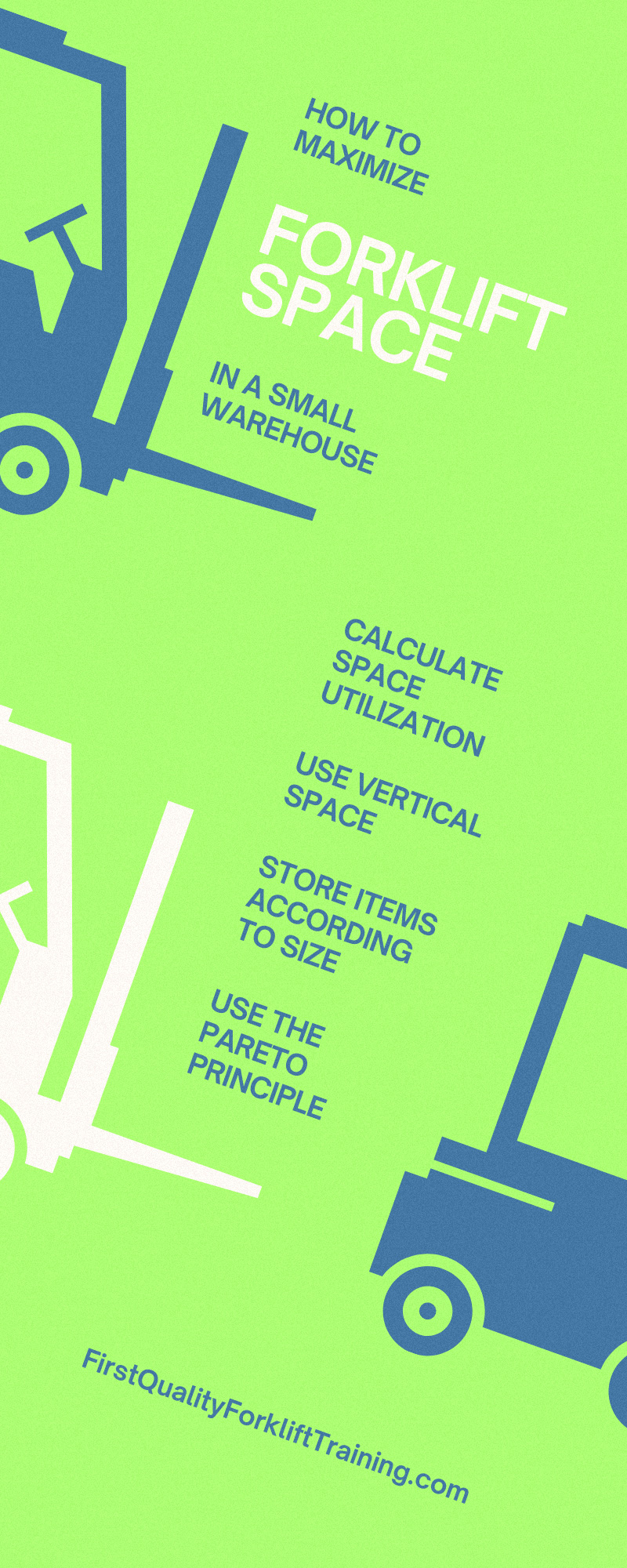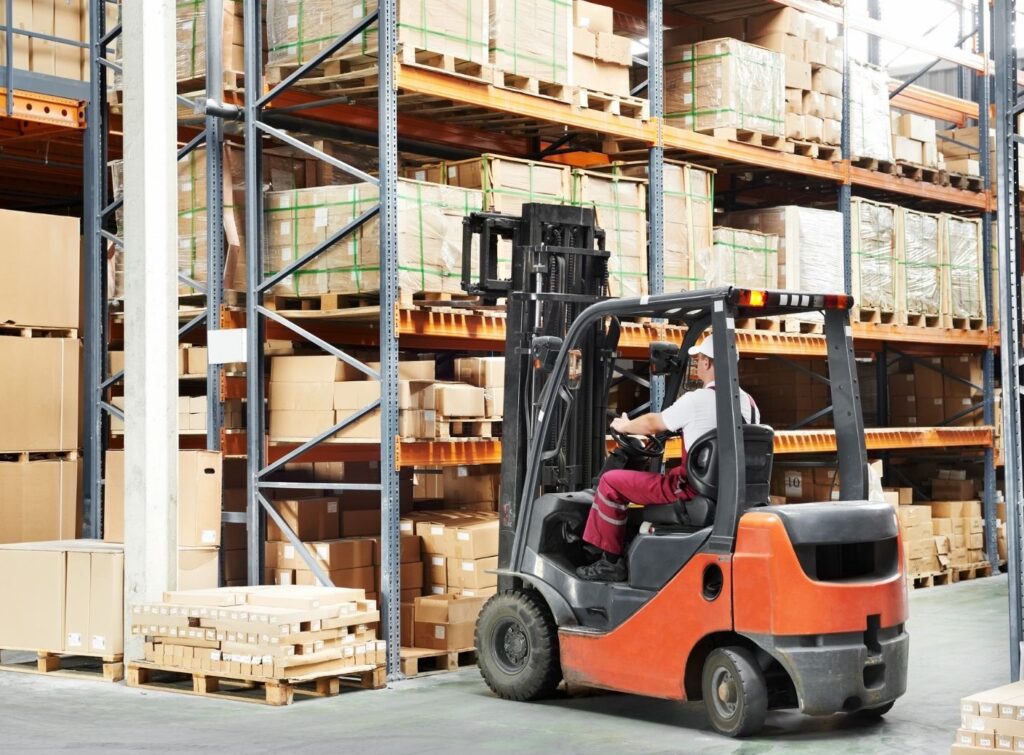Forklift Operator Safety Training
How To Maximize Forklift Space in a Small Warehouse
When selecting equipment to balance the ratio between shelf space and the paths to walk between aisles, we need to consider how high our shelves are or our aisles’ narrowness and how we utilize space. Here are tips to follow while learning how to maximize forklift space in a small warehouse.
Calculate Space Utilization
We can use some trusted metrics to determine better how much space is utilized in a cramped space and how many corners we neglect. These metrics help calculate the total warehouse size, thus helping warehouse workers manage the storage space efficiently.
Furthermore, these are the steps to help us find what we need to know for the total warehouse size. First, begin with the facility’s square footage. Take away office space, bathroom, and other non-usable space. Take the total and multiply the remaining square footage by the overhead object’s height. You now have your total size.
Another thing to look for to help us learn how to maximize forklift space in a small warehouse is figuring out our storage area size. To do so, first collect the outside dimensions length and width, then multiply by your highest load of that area. The sizes won’t always be equal, so make all calculations separately if there are mixed numbers. You will then have your cubic feet size.
Next, you need to find the potential space of your storage area. Now that you have storage area size and total warehouse size, you divide both and then multiply by 100. The percentage tells you how much workers utilize space. If it’s between 22 and 27%, there’s more room for you to use beyond what we use.
After the math’s completed, analyze your data and compare it to what you’ve collected in the past. Using what you now know, reorganize all aisles to help make the areas balanced, and then return to the math to recalculate to ensure there’s enough space used.
Store Items According To Size
Another solution to maximizing your storage area is to coordinate all shipping loads by size. For example, if there’s space on the bottom and heavier loads, place those loads on bottom shelves and move smaller loads to the top to utilize space.
Use the Pareto Principle
In order to save space effectively, some methods likely need applying to make processes smoother and allow for more free space to use. So, apply the Pareto principle method.
The Pareto principle is a method that suggests 80% of all penalties come from close to 20% of all causes. In other words, we have so much stored in different parts of our storeroom because of mismanaged space.
For instance, we can study how packaging numbers on products help us group things better. We can begin analyzing growth projects, then using that measurement can help condense loads that make sense to a company.
Use Vertical Space
Adding additional space on the ground is tough, but we can expand by using the vertical space currently available. Here’s what to know about using vertical space in a small warehouse.
Determine Clear Height
The distance determines the clear height from the floor to an overhead object.
Find Out Building Codes
Before working with or adding vertical space, ensure that changes meet all local building codes. Additionally, ensure the proper licensure is acquired before changing anything.
Look Over Inventory
Take a look at what’s available right now and what’s coming at a later time. Employees can move shipments that don’t sell as often to higher shelves to allow room for newer inventory.
Do Research
It’s essential to perform research on any part of a warehouse expansion or make the most of a small warehouse.
Clean Up the Floor
When looking over these tips, another thing to think about is what’s on your floors. The most valuable inventory comes from warehouses with pristine floors and has plenty of room to move along.
Cleaning floors can make navigating around on a forklift much easier, especially if workers are still training.
Take Out Waste
Waste is not a fun thing to drive around or near. It can cause severe accidents and prevent workers from performing their tasks most of the time.
So, to help control debris, do a sweep at the beginning and end of every shift. When workers finish sweeping, they won’t need to do extra duties while trying to sort.
Maintain Unused Equipment
Unused equipment can get in the way of performing a job. So, while idle equipment gets neglected, workers lack proper machinery to make moving loads quicker and more efficient.
Don’t leave equipment sitting; always return them to their charging station, so it’s ready for the next worker to use. Additionally, test them and do maintenance checks to ensure the machines are in working condition.
Inspect Unused Pallets
Pallets can even get in the way if not cared for properly. When sorting through products, accumulate all pallets first and check them over. If they’re in good condition, reuse them. If they aren’t, recycle all broken pallets.
Use Cross Docking
With an overbearing amount of stock, we lose sight of organizing. So, to make sorting simpler, implement the cross-docking method. Here’s what you need to know:
- Always research the cross-docking method before installing any part of the process.
- Find out if the docking process is possible for your warehouse; many cannot handle this practice.
- Analyze the products the warehouse carries—if it’s high-demand retail products or other items that were pre-picked, the warehouse might be able to use cross-docking.
- Additionally, technology needs to be updated, and the organization needs to be at its finest.
- Strict practices of inventory control need adding.
- All employees must train if any new procedures are added.
Every method explored here is further to help organize a smaller warehouse more efficiently.
As every worker learns new procedures, many need to watch the Raymond reach truck training video to learn the necessary methods and help them receive their certification for the class II narrow aisle forklift.
First Quality Forklift Training provides special forklift training software to help recruits earn their certification in forklift operating systems and encourage current drivers and supervisors to renew their skills.
Contact us here for more information on the narrow aisle forklift training kit, and many other of our training kits.



